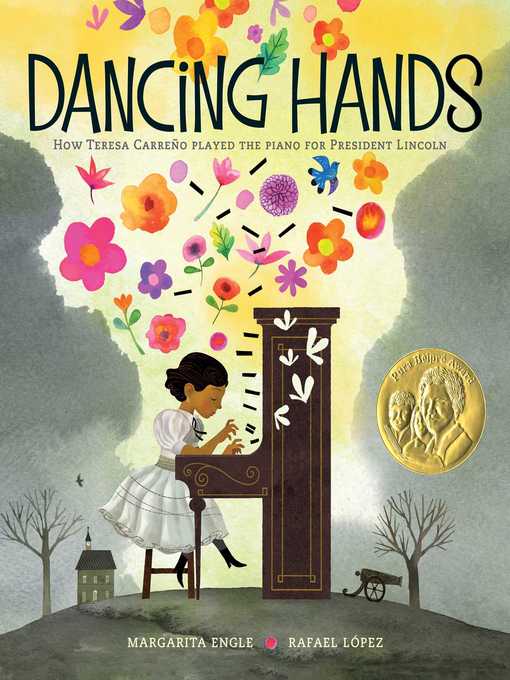
Dancing Hands
How Teresa Carreño Played the Piano for President Lincoln
چگونه ترزا کارینو برای رئیس جمهور لینکلن پیانو می نواخت
فرمت کتاب
ebook
تاریخ انتشار
2019
Lexile Score
1260
Reading Level
4
ATOS
5.5
Interest Level
K-3(LG)
نویسنده
Rafael Lópezشابک
9781481487412
کتاب های مرتبط
- اطلاعات
- نقد و بررسی
- دیدگاه کاربران
نقد و بررسی

June 1, 2019
Venezuelan pianist Teresa Carreño performs for President Abraham Lincoln amid a raging Civil War in Engle and López's portrait of an artist. Thanks to parental encouragement, Teresita learned about "all the beautiful / dark and light keys / of a piano" at an early age. By the age of 6, she composed original songs. Revolución in Venezuela soon drove an 8-year-old Teresa and her family to sail across the stormy sea to the United States, but the Carreño family arrived only to find another violent conflict--"the horrible Civil War"--in their adopted country. Despite the initial alienation that comes from being in an unfamiliar country, Teresita continued to improve and play "graceful waltzes and sonatas, / booming symphonies, and lively folk songs." The Piano Girl's reputation spread far, eventually garnering the attention of Lincoln, who invited the 10-year-old to perform at the White House! Yet the Civil War festered on, tormenting Teresita, who wished to alleviate the president's burdens for at least one night. "How could music soothe / so much trouble?" Half biographical sketch, half wide-eyed tribute, Engle and López's collaboration endearingly builds to Teresa's fateful meeting with Lincoln like a gravitational pull, with bursts of compassion and admiration for both artist and public servant. Engle's free verse whirls and twirls, playful and vivacious, while López's vivid, colorful artwork elevates this story to heavenly heights. Like a concerto for the heart. (historical note) (Informational picture book. 4-6)
COPYRIGHT(2019) Kirkus Reviews, ALL RIGHTS RESERVED.

July 8, 2019
In the dark days of the Civil War, a girl named Teresa Carreño sat down at a badly tuned piano to play for a special audience: Abraham Lincoln and his family. This book tells the story of how a young refugee from Venezuela comforted the grieving president with her music. Music helps Carreño express her feelings and cope with her family’s emigration to the U.S.—“Without a new piano, Teresa would have felt even more lonely.... Teresa practiced... her strong hands accepting the challenges of life’s many dark and light moods.” Her reputation as a prodigy leads to an invitation at the White House. Intimidated, she tries her best—“the memory of meeting past challenges now helped her fingers dance.” López’s swirling colors, soaring birds, and scattered notes conjure music’s transportive powers amid the countries’ war-torn landscapes, complementing Engle’s text, and building “hymns... shimmered like hummingbirds.” Ages 4–8.

August 1, 2019
PreS-Gr 2-Teresa Carreño achieved global fame as a performer, composer, pianist, and opera singer. By the age of six, she was composing. At the age of seven, she began performing. Revolution in Venezuela forced the Carreño family to migrate to New York, an unfamiliar place where few people spoke Spanish and her family felt out of place. But war would follow them-in 1863 the United States was in the midst of the Civil War. At the age of 10, Carreño was invited to play for President Abraham Lincoln and his family at the White House. But will a poorly tuned piano diminish her performance? This is a story of overcoming fear and using one's talents to spark joy despite unforeseen obstacles. Author and illustrator are well paired in this interesting narrative. Darks and lights, whether representing world events or the colors of the piano keys, are recurring themes that Engle cleverly entwines in her at times poetic writing. López's illustrations practically leap from the page as they mirror the tone of events-bright and beautiful when the story is light; dark, drab, and gray when echoing conflict. A historical note in the back matter provides slightly more insight, but Engle's writing occasionally seems to take liberties with individual characters' thoughts and emotions with little supporting evidence. VERDICT Despite the efficacy of the author and illustrator collaboration, the historical facts remain somewhat sketchy throughout the narrative. A gentle title to add cultural insight to any collection, though possibly best for larger budgets.-Rebecca Gueorguiev, New York Public Library
Copyright 2019 School Library Journal, LLC Used with permission.

June 1, 2019
Grades 1-3 Engle and L�pez pair up again to bring equality to the arts in this picture-book biography of pianist and composer Teresa Carre�o. More detailed than their Pura Belpr� Honor Book, Drum Dream Girl (2015), the lyrical, imagery-rich text alternates between prose and free verse as it describes Teresa's early childhood in Venezuela in the mid-1800s. When a revolution tears through the country, the young prodigy and her family move to New York, where she feels like an oddity and where a civil war also wreaks havoc. Concerts around the world, however, spare the newly proclaimed Piano Girl from much of this pain. An invitation from the White House to play for the grieving President Lincoln and his family almost turns disastrous due to a poorly tuned piano, but Teresa's perseverance saves the evening in the story's climax. Patterned mixed-media illustrations use color to evoke the lushness of Venezuela, the darkness of war, and the beauty of music. Concluding with a historical note, the biography's vibrant images and language form a melodious composition.(Reprinted with permission of Booklist, copyright 2019, American Library Association.)

























دیدگاه کاربران